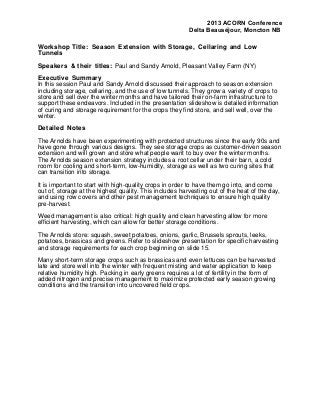
Part 1: Season Extension with Storage, Cellaring & Low Tunnels with Paul & Sandy Arnold
- 1. 2013 ACORN Conference Delta Beauséjour, Moncton NB Workshop Title: Season Extension with Storage, Cellaring and Low Tunnels Speakers & their titles: Paul and Sandy Arnold, Pleasant Valley Farm (NY) Executive Summary In this session Paul and Sandy Arnold discussed their approach to season extension including storage, cellaring, and the use of low tunnels. They grow a variety of crops to store and sell over the winter months and have tailored their on-farm infrastructure to support these endeavors. Included in the presentation slideshow is detailed information of curing and storage requirement for the crops they find store, and sell well, over the winter. Detailed Notes The Arnolds have been experimenting with protected structures since the early 90s and have gone through various designs. They see storage crops as customer-driven season extension and will grown and store what people want to buy over the winter months. The Arnolds season extension strategy includes a root cellar under their barn, a cold room for cooling and short-term, low-humidity, storage as well as two curing sites that can transition into storage. It is important to start with high-quality crops in order to have them go into, and come out of, storage at the highest quality. This includes harvesting out of the heat of the day, and using row covers and other pest management techniques to ensure high quality pre-harvest. Weed management is also critical: high quality and clean harvesting allow for more efficient harvesting, which can allow for better storage conditions. The Arnolds store: squash, sweet potatoes, onions, garlic, Brussels sprouts, leeks, potatoes, brassicas and greens. Refer to slideshow presentation for specific harvesting and storage requirements for each crop beginning on slide 15. Many short-term storage crops such as brassicas and even lettuces can be harvested late and store well into the winter with frequent misting and water application to keep relative humidity high. Packing in early greens requires a lot of fertility in the form of added nitrogen and precise management to maximize protected early season growing conditions and the transition into uncovered field crops.